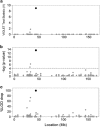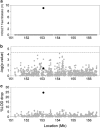A novel method, the Variant Impact On Linkage Effect Test (VIOLET), leads to improved identification of causal variants in linkage regions
- PMID: 23736220
- PMCID: PMC3895640
- DOI: 10.1038/ejhg.2013.120
A novel method, the Variant Impact On Linkage Effect Test (VIOLET), leads to improved identification of causal variants in linkage regions
Abstract
The Human Genome Project was expected to individualize medicine by rapidly advancing knowledge of common complex disease through discovery of disease-causing genetic variants. However, this has proved challenging. Although linkage analysis has identified replicated chromosomal regions, subsequent detection of causal variants for complex traits has been limited. One explanation for this difficulty is that utilization of association to follow up linkage is problematic given that linkage and association are not required to co-occur. Indeed, co-occurrence is likely to occur only in special circumstances, such as Mendelian inheritance, but cannot be universally expected. To overcome this problem, we propose a novel method, the Variant Impact On Linkage Effect Test (VIOLET), which differs from other quantitative methods in that it is designed to follow up linkage by identifying variants that influence the variance explained by a quantitative trait locus. VIOLET's performance was compared with measured genotype and combined linkage association in two data sets with quantitative traits. Using simulated data, VIOLET had high power to detect the causal variant and reduced false positives compared with standard methods. Using real data, VIOLET identified a single variant, which explained 24% of linkage; this variant exhibited only nominal association (P=0.04) using measured genotype and was not identified by combined linkage association. These results demonstrate that VIOLET is highly specific while retaining low false-negative results. In summary, VIOLET overcomes a barrier to gene discovery and thus may be broadly applicable to identify underlying genetic etiology for traits exhibiting linkage.
Figures



References
-
- Perola M. Genetics of human stature: lessons from genome-wide association studies. Horm Res Paediatr. 2011;76 ((Suppl 3:10–11. - PubMed
-
- Risch N, Merikangas K. The future of genetic studies of complex human diseases. Science. 1996;273:1516–1517. - PubMed
-
- Sladek R, Rocheleau G, Rung J, et al. A genome-wide association study identifies novel risk loci for type 2 diabetes. Nature. 2007;445:881–885. - PubMed
Publication types
MeSH terms
Grants and funding
LinkOut - more resources
Full Text Sources
Other Literature Sources

